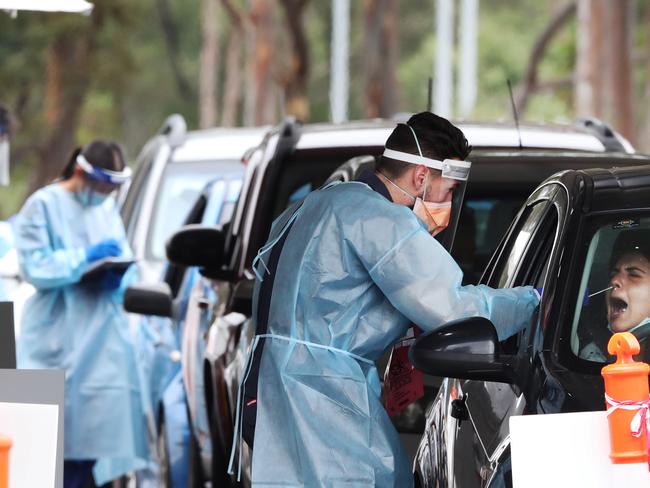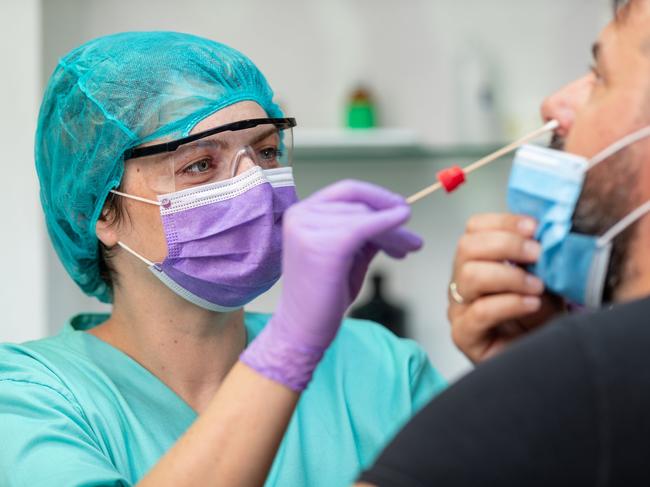COVID-19: Why we haven’t seen more of the UK strain in the community
If the UK strain of COVID-19 is more contagious, why haven’t we seen more cases in the Australian community?
A hotel quarantine worker at the Holiday Inn near Melbourne Airport with COVID-19 has become the latest case confirmed to have the more infectious UK variant of the virus.
So far the UK strain has emerged in Victoria, Queensland and Western Australia but has mostly been confined to hotel quarantine.
But if the UK strain of COVID-19 is more contagious, why haven’t we seen more cases in the Australian community?
Melbourne School of Population and Global Health epidemiologist Tony Blakely puts it down to luck – but thinks that luck will likely run out soon.
Professor Blakely said while the strain hadn’t leaked from quarantine to cause a large community outbreak yet, the number of observed cases had been small.
Also, roughly 80 per cent of infected people tended not to be superspreaders, so it could be that those who have had the strain fell into this group, he said.
“The most likely explanation is that we’ve got lucky so far in that the people who have this more transmissible virus and happen to have been moving around our community just happen to have also been the people who don’t spread it as much,” Professor Blakely says.
“If my deductions are correct … it would also imply that some time we’re going to get unlucky soon.
“We will see an outbreak somewhere if we keep letting that slip through quarantine.”

Two workers in Melbourne quarantine hotels were found to have the variant in the last week, prompting a snap tightening of restrictions.
Brisbane also went into a three-day lockdown last month, triggered by the infection of a cleaner at the Hotel Grand Chancellor that became a six-person cluster.
And Western Australia has just emerged from five-day lockdown after a security guard at the Four Points Sheraton quarantine hotel tested positive to the UK strain of coronavirus.
Professor Blakely said more testing and better contract tracing could be reasons why more outbreaks of the UK strain hadn’t been in the community.
Increased testing of people at the start and end of quarantine could be detecting mild cases from these overseas variants that weren’t tested for previously.
“So far we’ve just been lucky. But there may also be the fact that we’re finding out about things we never used to know about,” Professor Blakely said.
“When we do see a leakage out of quarantine, those contact tracers really get ahead of it fast, it’s quite excellent.
“The contact tracing is finding people quicker, so even for within household and close contact spread, there’s less time for them to spread it. So we may just be cutting it off really fast.”

Australian National University infectious diseases expert Peter Collignon says while the UK strain appears more transmissible, it is not to the extent being made out.
“We’ve had a lot of UK strains into Australia, including people who are out in the community,” Professor Collignon said.
“Yet it hasn’t been any more transmissible – if fact, you could argue it may be less – than other strains we’ve had.
“There’s a certain amount of panic about this UK strain that is probably not quite proportional to (what) the data overall shows.”
Professor Collignon said the UK strain was perhaps 30 per cent more transmissible.
But he said people’s behaviour must also be considered when considering how contagious it is.
He points to the UK, where there was a great number of people moving around before Christmas and pre-lockdowns, particularly younger people who tend to carry that strain more.
“One of the issues with seeing more of a viral strain – is it the strain itself or is it the people carrying the strain?” Professor Collignon said.
“The bottom line is it’s still transmitted exactly the same way as all the other strains.
“Just say it’s 30 per cent more transmissible – if you have three people with another strain, that’s much worse than one person with the UK strain.”

Professor Collignon said the strain “hasn’t really galloped away in a lot of other countries” and in any case, would change with time.
“In Denmark, for instance, it’s a bigger percentage of strains, but the overall numbers are actually still low and the numbers are going down,” he said.
“So, I think we’ve got to be a little bit circumspect in not over-interpreting percentage changes and also, in retrospect, trying to work out how much of it is due to the strain being more transmissible – which I think, the UK strain is – but not as much as people think it is.”
Professor Collignon said the summer season could be another reason why the UK strain hadn’t spread widely into the community yet.
“Our most recent experience with these strains across various capital cities suggests what we’re doing at least in our summer is working quite well,” he said.
“It may be because we’re in summer. If you look at all these viruses, they spread much more easily in winter.
“We may have luck on our side in that we’re in summer and we’ve got very good control of COVID in Australia currently.
“What happens next winter? It’s very important we don’t become complacent.”

Hand hygiene, mask wearing, keeping away from others and staying home from work if sick and social distancing markedly reduced the risk of catching or passing on coronavirus, Professor Collignon said.
“I don’t actually think we need to change the simple stuff, we just need to keep on doing it – which I might say often is not done if you look at crowded indoor facilities,” he said.
“It’s a message that we’re unfortunately going to have to keep doing this in my view at least until the end of this year and probably longer.
“Until COVID gets down to very low levels globally, we’re going to have this ongoing risk.”
“We just need to do some of our hotel quarantine a bit better than it’s being done.”
Professor Collignon also said more attention needed to be given to eye protection from virus droplets and corridors in quarantine, whereby a positive case could open a door and potentially pass the virus onto a security guard, for example, without a mask or eye protection.


